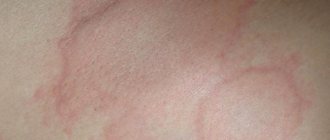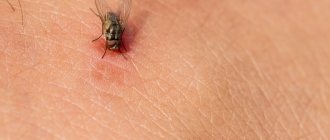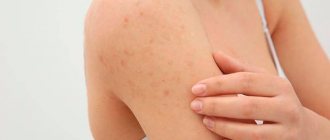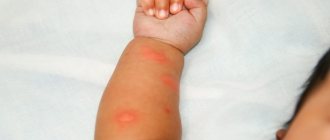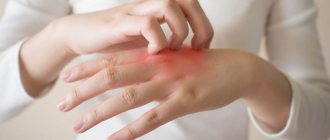Last update: 02/20/2021
Author of the article: pediatrician Valentina Razheva
In everyday life, we come into contact with a huge number of allergens, sometimes without even knowing it. And it goes without saying that the least protected areas of the skin take the blow. We are talking about the hands with which we wash dishes and do cleaning, grab snowballs in winter, forgetting about gloves, and rarely apply sunscreen in summer. But in addition to external irritants, there are many other reasons why allergies occur on the skin of the hands.
Causes of hand skin allergies
- Prolonged or regular contact of unprotected hands with household chemicals. Modern detergents contain active, strong chemicals, especially bleaches and plumbing cleaners.
- Allergies on the palms can also occur when using inappropriate cosmetics: low-quality soap or cream that contains allergenic components.
- Long-term use of medications, especially antibiotics.
- Some food products: nuts, milk, eggs, honey, citrus fruits and others.
- Unstable emotional state, stress, nervous exhaustion.
- Reaction to cold, sun and other weather conditions.
Allergies in the form of red spots: causes of appearance and localization
Regardless of the nature of the skin rashes, they should alert you. In any case, this is a signal from the body to any internal problems or to external influences. And in the case of allergies, the most important thing is to eliminate its source. This is why it is important to understand that red spots on the face or body are allergic in nature.
The main causes of allergies and red spots include:
- Reaction to external irritants: allergies to household chemicals, cosmetics, animal hair, plants are most often accompanied by the appearance of red spots directly at the sites of contact with the allergen (also called contact dermatitis). The skin of the hands, feet, face, and neck suffers.
- Long-term use of medications, especially antibiotics, can also provoke an allergic reaction. Locations of allergies and the red spots that accompany them can be found throughout the body.
- Food allergies to certain allergenic foods and poor nutrition in general often cause the appearance of red spots in the abdomen, face, arms and legs. This reaction also occurs with vitamin deficiency or hypervitaminosis, i.e. when there are not enough vitamins or too many of them.
- Nervous exhaustion, stress, and unstable emotional state also affect the condition of the skin. If you have recently experienced a strong outburst of emotions, after which you noticed red spots on your body, this is a reason to consult a dermatologist and neurologist.
- The skin is irritated and red from allergies to cold and sun. More often, its manifestation is noticeable in areas of the skin that are most exposed to weather conditions due to the fact that they are not protected by clothing - these are the hands and face.
Types of hand allergies: how to recognize the cause from the symptoms?
Cracked palms, itching, burning, dryness, rash, red spots are the most common symptoms of hand allergies. The most painful and unpleasant manifestation of an allergic reaction is when the hands crack, swell, and may become covered with hard crusts and small ulcers. In this case, it is almost impossible to bend the fingers; every movement is accompanied by pain.
In fact, any manifestation of an allergy is the body’s reaction to various factors that provoke such a condition. In most cases, by the appearance of an allergy on the hands, it is possible to understand the cause of its occurrence.
- Allergies between the fingers most often develop as a result of contact with household chemicals. It appears almost instantly after direct contact of the chemical with the skin, accompanied by itching, red spots and even blisters. Since the fingers are often bent, the skin cracks in places where the rash occurs and wounds form.
- If you notice redness of your hands after going outside, which is accompanied by dry skin and soreness, it may be a hand allergy to the cold. Its external manifestations are similar to frostbite, and one of the main symptoms is pain. The skin in general looks unhealthy, thin, redness does not go away, even if you are already indoors.
- Redness, accompanied by swelling of the hands, the appearance of bubbles with a colorless liquid, similar to a burn, itching and burning of the skin: all these are alarming symptoms that can mean a serious disease - allergic dermatitis. Dermatitis develops with repeated contact with an allergen and eventually becomes chronic. The skin of the hands thickens, thickens, and constantly peels off: this condition is much more difficult to treat.
- The appearance of allergies on the crooks of the arms, elbows, as well as the presence of similar rashes on the legs and face are a reaction to poor nutrition. This may be excessive consumption of sugar, allergenic foods (for example, citrus fruits), or general food poisoning from low-quality products.
- Severely itchy pinpoint rashes on the hands indicate increased sensitivity to insect bites or burns from poisonous plants.
If these symptoms are accompanied by fever and swollen hands, then this is an allergy.
Please note that all symptoms of hand allergies can also accompany bacterial or fungal skin lesions, so before treatment, be sure to consult a dermatologist for an accurate diagnosis.
Allergy in a child in the form of red spots
Allergic spots appear especially often in young children. Moreover, the reaction can appear completely suddenly and on any part of the body. The reason should be, first of all, looked for in the menu of a baby or a nursing mother. The child's body instantly reacts to unusual foods or familiar ones, but in too large quantities.
If red spots appear on the child’s face, arms, legs, or in the groin area, they itch, peel, and begin to become wet, this may be diathesis. It develops as a result of malnutrition, food allergies, hormonal imbalance, and also due to improper functioning of the body.
Contact allergies occur when there is direct contact with an allergen. It could be washing powder, after which you didn’t rinse your laundry, synthetic or even woolen fabrics well. In this case, spots appear on the palms, cheeks and other parts of the body with which the baby came into contact with an aggressive surface.
Even after stopping contact with the irritant, spots on the skin remain for several days. If they cause discomfort to the baby, then the affected areas must be especially carefully cared for. In addition, constant itching causes scratching, which can become infected, and then serious skin treatment will be needed.
When the cause is not an allergy
Red spots on the skin do not only occur as a result of an allergic reaction.
- Infectious diseases make themselves felt at the development stage in the form of rashes on the body. They usually cover a large area of the dermis and are accompanied by an increase in temperature. Such diseases include chickenpox, measles, scarlet fever, rubella, ringworm, meningitis, and typhoid fever.
- Diseases of internal organs often manifest themselves in the form of skin rashes. The appearance of a red rash may indicate vegetative-vascular dystonia, disorders of the nervous system, an unhealthy stomach, heart, or the presence of tumor diseases.
- Dermatological nature of the rash. Most skin diseases manifest themselves in the form of skin hyperemia, expressed by obvious redness and itching. The most common cases are eczema, psoriasis, dermatitis, lupus erythematosus, seborrhea, and lichen.
Medicine knows more than fifty diseases that are accompanied by a similar symptom. Therefore, accurate diagnosis is very important, and only a specialized dermatologist can carry it out after a series of tests. He will also determine the exact allergen, if the cause of the appearance of red spots is still in it, and prescribe the appropriate treatment.
Allergies in the hands of a child and an adult: what is the difference
Children are more likely to have allergic reactions to food than adults because they may consume allergenic foods in large quantities without realizing it, simply because it tastes good. Sweets, citrus fruits, fast food - all these are potential allergens that an adult who is prone to allergies avoids. But it is children who are less likely to be allergic to household chemicals and cosmetics simply because they do not abuse them.
In a child, especially an infant, an allergy on the hands in the form of red spots may indicate an infectious disease, because The immune system of a very small person has not yet learned to fight diseases and thus reports them.
In any case, the child tolerates allergy symptoms worse: not every adult can cope with constant itching and painful sensations, and children may still develop a fever. Therefore, when the first signs of an allergy appear, immediately contact a specialist and begin treatment. By the way, children often “outgrow” hypersensitivity to what was an allergen in childhood, and after that they may not suffer from such a reaction.
Prevalence
According to medical statistics, about 15% of the population have had signs of contact dermatitis at least once in their life, and every year 7% of people experience contact hypersensitivity of the skin. It occurs with approximately the same frequency at any age, including contact allergies in children.
The most common allergy is nickel , it occurs in 10% of women and 1% of men. Therefore, for example, people who decide to get piercings with nickel jewelry expose themselves to additional risks.
What to do if you have an allergy on your hands: immediate help
- Identify the allergen and immediately eliminate contact with it.
- Wash your hands using a mild detergent - La Cree gel. It will carefully cleanse the skin and cover it with a protective layer that minimizes the harmful effects of the environment.
- If you have swelling, then use the folk method, take a bath with string, sage or chamomile, use only purified soft water, without bleach.
- Apply La Cree cream to your hands. This product not only quickly moisturizes the skin, but also copes well with itching and burning. It has a healing and antimicrobial effect: helps speed up skin regeneration.
Causes and symptoms of dermatitis on the hands
The cause of contact dermatitis on the hands is mechanical, physical, chemical or biological effects on the skin: wearing metal jewelry, latex or wool gloves, exposure to household products, plant sap, pollen, ultraviolet radiation, cold, cosmetics such as nail polish or skin cream. hands
Allergic dermatitis on the hands develops under the influence of allergenic substances that enter the body - medications, food products, dust, chemical fumes. In this case, acute inflammation of the skin is called toxicerma. Allergic hand dermatitis often develops in people who have a predisposition to other allergic diseases, for example, bronchial asthma, seasonal allergies, etc. The appearance of skin lesions on the hands can take from a few minutes to several months after the allergen enters the bloodstream.
Genetically determined hypersensitivity of the immune system to a certain factor is the cause of atopic dermatitis.
Dermatitis on the hands is accompanied by vivid symptoms. The first of these is itching, which leads to scratching of the skin. Redness, burning, small watery blisters or blisters appear on it. The joints on the hands - fingers and wrists - become difficult to bend due to their swelling, the skin loses its elasticity, and deep, weeping cracks appear. It becomes difficult to move your hands, even washing them or putting on gloves causes pain. In addition, due to discomfort and itching, sleep is disturbed; the patient may wake up several times during the night.
Hand allergies: treatment
Treatment of hand allergies should be taken very seriously. The most important thing is not to let the disease progress and consult a doctor immediately. The fact is that a seemingly mild illness can turn into a serious illness and develop into eczema, the treatment of which will take a long time.
Modern medicine makes it possible to determine exactly what the allergen is through several laboratory tests and studies. Don’t be lazy and go get them done so you know exactly what you’re allergic to.
To combat allergies, complex therapy is usually prescribed, including the use of drugs internally and agents for external use:
- Antihistamines – primarily relieve symptoms such as itching and rash. If you have an itchy allergy on your hands, both ointments and taking pills will help.
- Antiallergic drugs that affect the immune system and prevent the development of allergies.
- Enterosorbents are prescribed orally; they are effective if allergies in the hands are caused by a reaction to food.
- Corticosteroids contain hormones and are therefore prescribed exclusively by a doctor for the treatment of chronic or severe allergies. They have an anti-inflammatory effect and relieve itching.
- Antibiotics are prescribed by a doctor in advanced cases of allergies, when non-healing wounds form on the hands, eczema, which has gotten into dirt, and inflammation has begun.
- Creams to relieve external allergy symptoms. Cosmetics become constant companions for hand allergies, because they perfectly soften and moisturize dry, damaged skin, protect it from negative external influences, which allows minimizing the use of hormonal ointments and creams. The La-Cri cream performed especially well. This remedy is recommended both for the prevention of allergies and for eliminating the first signs of the disease. It is important to note that La-Cri medicinal cosmetics do not contain hormones, fragrances or dyes. The cream has a natural composition (natural oils, herbal ingredients of the highest quality), so it can be used until the allergy is completely cured and as a preventive measure.
Treatment
If you have itchy, watery blisters on your hands, seek help. The more severe the rash, the more often they are accompanied by a deterioration in general condition and an increase in temperature. If the blisters grow, turn red and hurt (possibly even fester), and the area around them swells, it is better to call an ambulance, as there is a high probability of infection.
In any case, only a doctor will determine the exact cause of the disease and tell you how to treat the blisters on your fingers. Don't panic: in the vast majority of cases, rashes go away as soon as the cause of their occurrence is eliminated. This may happen in a few days or weeks.
Treatment of the disease is chosen after diagnosis. If the cause of the itchy rash is scabies, it will be treated with external medications within a week. The therapy uses sulfur ointment for watery blisters on the hands and other medications.
If the rash in children or adults is caused by chickenpox, the patient may be hospitalized. For mild forms, treatment is possible at home. Patients are recommended antiviral and antipyretic drugs and local remedies that dry out pimples.
Fungal blisters are treated with topical creams and ointments. They are used to treat the affected areas. Often such drugs are toxic, so only a doctor should select them.
If watery blisters on the hands become an allergic reaction, treatment will be carried out using antihistamines: internal and external.
In any case, you should not diagnose yourself. This can only harm you. Let your doctor determine the cause of the problem and tell you what to do.
Prevention is the best treatment: how to prevent hand allergies
It doesn’t matter whether you are prone to allergies or not, be sure to follow preventive measures and you will never encounter allergies on the skin of your hands:
- When using household chemicals, wear gloves with a cotton lining.
- Choose detergents and hand cosmetics that are labeled “hypoallergenic.”
- In cold weather, protect your hands from the cold: wear mittens or gloves. And in the summer, don’t forget to apply sunscreen on the backs of your hands.
- Eliminate allergenic foods from your diet. Try to eat healthy and balanced.
- Strengthen your immune system with vitamins prescribed by your doctor.
- Avoid stress and nervous conditions, follow the regime, give up bad habits.
- Don't forget to take care of your hands: regularly moisturize and soften your skin.
Contact allergy: treatment
Antihistamines are prescribed to reduce the symptoms of the disease. Hormonal ointments are applied to the damaged area.
In severe cases of contact allergies, the doctor prescribes oral glucocorticoids.
Do not forget that many allergy medications are contraindicated for children and pregnant women.
The only safe remedy for contact allergies is Enterosgel! Thanks to its unique structure, it safely binds and removes allergens from the body without affecting beneficial substances and microelements.
Clinical researches
Conducted clinical studies prove the high efficiency, safety and tolerability of the products. The cream for sensitive skin is suitable for daily care of adult and children's skin with mild to moderate forms of atopic dermatitis and during remission. As a result of therapy, a decrease in the activity of the inflammatory process, a decrease in dryness, itching and flaking was noted.
The products are recommended by the Union of Pediatricians of Russia.
Sources:
- Bonifazi Ernesto, Differential diagnosis in pediatric dermatology, Panfilov Publishing House, Binom. Knowledge Laboratory, 2014.
- Churolinov Petr, Herbal medicine in dermatology and cosmetics, Medicine and Physical Education, 1979.
- Schneiderman Paul, Grossman Mark, Differential diagnosis in dermatology. Atlas, Binom, 2022.
